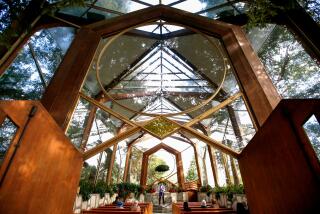Danes Find Home in Yorba Linda Ministry
- Share via
Every Sunday, Danes journey from all over Southern California to a place more Danish than Solvang--the Emanuel Danish Evangelical Lutheran Church in Yorba Linda.
The church is far more than a church. It also is a refuge for homesick immigrants, a social center and a place for second-generation Danish-Americans to explore their heritage.
In addition, “You could call the church an unofficial extension of the embassy,” said pastor Carsten Boegh Pedersen. The church works closely with the Danish consulate in Los Angeles, which notifies him if a Danish national needs help, Pedersen said.
He also visits those who are sick or in need, some of whom don’t speak English.
“Suddenly, the need for a Danish community will arise,” Pedersen said. “When someone’s loved one dies . . . the family need to hear the words in Danish.”
Built five years ago in a Gothic and Romanesque style, the church at 16881 Bastanchury Road also provides an architectural link to the Old World: the building resembles a typical Danish country church.
Aside from the Danish Seaman’s Church in New York City, it is the only Danish church in the nation. Though the church has about 400 active members, it caters to a much larger population of about 10,000 Danes in Southern California.
Although the Lutheran church enjoys semi-official status in Denmark, Emanuel Danish Evangelical is administratively and financially independent. It belongs to the Evangelical Lutheran Church of America, and follows liturgical practices of that denomination--apart from Danish traditional hymns translated into English that are sung by the congregation.
The church provides a place where immigrants can share cultural references and rediscover their Danish identity, Pedersen said.
“When you leave [your country], you feel it inside you,” Pedersen said. “You get a need to be with your fellows.”
Somewhere to turn for help and support--and perhaps a herring on dark rye.
Bent Jul of Fountain Valley and his wife, Lizette, often visit the church to participate in Danish smorgasbord lunches, as well as other social activities, such as sing-along nights.
Other events at the church include a weekly Danish-language tutorial, and a monthly gathering for au pairs and students, where young Danes meet over coffee to talk about living away from home.
“The church is so much more than what a church would be in Denmark,” said Jul, a retired construction worker who immigrated 48 years ago. “On many occasions, the church will help Danes in distress.”
*
Despite its focus on Danish tradition, the church is open to everyone. Because Danes are not immigrating in the numbers they once did, Americans with a Danish heritage are needed to ensure the future of the church, Jul said.
“Many Americans attend too, and without them the church couldn’t exist,” Jul said.
Dianna Ennis from Anaheim is a second generation Danish-American. After her sister took her to the Yorba Linda church, she found more than just a place of worship.
The 48-year-old woman found a friend--the 85-year-old Karen Jensen--and with her, knowledge about her family in Denmark.
“I learned a lot about my family history from people here,” Ennis said.
Ennis also learned about Danish traditions, something her parents never explored, she said.
“I thought my connection to the Danish community was lost but then I came here and met people . . . and I got reconnected.”
Before Ennis began attending the Danish church, she belonged to a Lutheran church in Anaheim. “They preached hellfire and damnation,” Ennis said. “It frightens the children, and confuses the adults.”
The service in the Danish church is different, Ennis said.
“They tell you how precious you are. They speak about God’s love. It’s very uplifting--a breath of fresh air.”
To attract Americans like Ennis, the Sunday services take place in English, although the pastor conducts a monthly service in Danish.
On a recent Sunday, a small witch crouched on the pew, listening to the pastor.
Parents had brought their costumed children to the church for the celebration of fastelavn, a pagan custom incorporated into the church’s holy calendar.
During the celebration, which is not unlike Mardi Gras, children wear masks and costumes as they participate in slaa katten af toenden--or “beating the cat out of the barrel.”
The custom, in which children break a barrel with wooden bats, dates from around 1520. Then, the barrel contained a live cat, a symbol of evil that had to be exorcised. Today, however, it resembles a pinata, containing only candy.
“We try to maintain Danish traditions,” said Margit Haupt, a member of the church council. “Everybody here has a strong sense of being Danish-related.”
*
The council appoints a new pastor from Denmark every two years because pastors lose their pension plans if they take longer leaves from their parishes back home, Haupt said.
Despite the cost and inconvenience of revolving doors at the Yorba Linda parsonage, the council insists on a Danish pastor at the pulpit to connect the congregation to the country they left, Haupt said.
Though the building is new, the congregation traces its history in Southern California back nearly a century.
On the anniversary of the Danish Constitution, June 5, 1906, four Danish-Americans in Los Angeles decided they wanted their own church, and began conducting services in Danish. After 10 years, a Danish church was built on 46th Street. In 1937, the immigrants raised enough money to erect a church that included a meeting hall and a parsonage. It was built on the corner of 43rd Street and 3rd Avenue.
After 60 years, the Danish community decided to move the church out of the city, building a combined church and cultural center in Yorba Linda. On Sunday, the congregation will celebrate its five-year anniversary.
More to Read
Sign up for Essential California
The most important California stories and recommendations in your inbox every morning.
You may occasionally receive promotional content from the Los Angeles Times.













